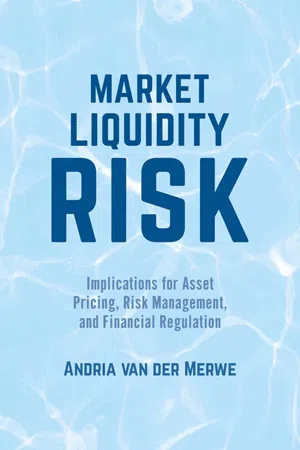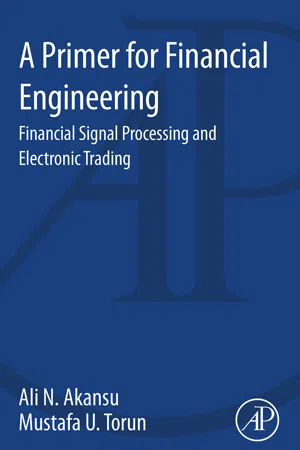Economics
Structure of Financial Market
The structure of financial markets refers to the organization and framework through which financial assets are bought and sold. It encompasses various components such as stock exchanges, bond markets, and money markets, as well as the intermediaries and institutions that facilitate trading. The structure of financial markets plays a crucial role in determining the efficiency and accessibility of financial transactions.
Written by Perlego with AI-assistance
Related key terms
5 Key excerpts on "Structure of Financial Market"
- eBook - ePub
Market Liquidity Risk
Implications for Asset Pricing, Risk Management, and Financial Regulation
- Andria van der Merwe(Author)
- 2016(Publication Date)
- Palgrave Macmillan(Publisher)
However, even though the underlying rules, processes, and roles of different agents are changing, the fundamental role of the market has not changed. In its most basic form, a market is an aggregation of buyers and sellers who interact according to a set of rules that determine what they can do, how fast they can do it, and what information is public versus private. The increased reliance on computerization and artificial intelligence in finance has fundamentally transformed the financial markets into faster, larger, more global, more interconnected, and less human entities than ever before.Our objective in this chapter is to further our understanding of market liquidity by looking at market structures. Our treatment investigates several distinct but related building blocks, such as the role of institutional arrangements, the role of technology, and the importance of capital. We explore questions such as how institutional arrangements and features of a particular structure either enhance or inhibit market liquidity, and how new capital requirements are changing the process of financial intermediation.1Market microstructure insights into security price formationIn an efficient market, security prices fully reflect all available information,2 and will accordingly change only in response to the arrival of new information.3 Market efficiency is a powerful concept of finance theory, it represents a market in which “prices provide accurate signals for resource allocation that is a market in which firms can make production-investment decisions, and investors can choose among securities that represent ownership of firms’ activities under the assumption that security prices at any time ‘fully reflect’ all available information.”4 This hypothesis convinces us of the usefulness of security prices, but it does not explain the process of how information is being incorporated into security prices.The Walrasian auctioneer provides the simplest characterization of price formation. According to this framework, a fictitious auctioneer orchestrates the price formation process in a setup without any time constraints. Traders submit and revise their orders until the auctioneer finds a market price that allows all purchase and sale orders to clear. This market-clearing price is the equilibrium price or fundamental value of the security. - eBook - ePub
Investment and Portfolio Management
A Practical Introduction
- Ian Pagdin, Michelle Hardy(Authors)
- 2017(Publication Date)
- Kogan Page(Publisher)
01Financial markets
By the end of this chapter you should understand the following key areas of financial markets:- the definition of financial markets;
- the history and development of financial markets;
- financial markets today;
- the categorization of markets;
- the key participants in a financial market;
- recent developments in financial markets;
- financial crises.
Introduction
As with the global fund management industry, which we cover in Chapter 2 , the financial markets provide a critical link between the providers of capital and those looking to use capital. Providers of capital include retail and institutional investors whilst users of capital include corporations and governments. Capital itself can include both debt and equity as well as other more exotic investments. Both providers and consumers of capital want transactions to be conducted efficiently, which, as we will see in Chapter 5 , includes transactions being conducted accurately, at low transaction costs, and with assets being valued at a fair price. One key aspect of financial markets over recent years is the pace of change which is being experienced due to increasing volatility in global markets, as well as developments in products, technology and investor sentiment. All of which make this industry dynamic and challenging for participants.Defining financial markets
The term ‘market’ in financial literature is used inconsistently and sometimes with little thought to the context of the situation. This is not a problem when you have been studying finance for a while as you will automatically know which market is being referred to in a piece of writing or conversation. However, when you first study finance it can make the area appear confusing and impenetrable. In the first instance, it helps to understand that a financial market or marketplace, unlike traditional food markets for instance, can be both a physical place and a virtual space. Additionally, the term ‘marketplace’ is often shortened to market, which again can make differentiation and understanding more difficult. - eBook - ePub
A Primer for Financial Engineering
Financial Signal Processing and Electronic Trading
- Ali N. Akansu, Mustafa U. Torun(Authors)
- 2015(Publication Date)
- Academic Press(Publisher)
Chapter 2Financial Markets and Instruments
Abstract
We start with the definitions and descriptions of different entities in the financial markets and how they interact with each other. We introduce exchanges, electronic communication networks (ECNs), broker-dealers, market-makers, regulators, traders, and funds to better understand the financial ecosystem given that the legal framework, regulatory and compliance issues are beyond the scope of this book. In a separate section, we delve into the details of various types of financial instruments, i.e., stocks, options, futures, exchange traded funds (ETFs), currency pairs, and fixed income securities. Our goal in this chapter is not to provide the exhaustive details of these entities, instruments, and their relationships with each other. We rather aim to equip engineers with a good understanding of these concepts to navigate further in the area they choose to focus on through the references provided. We note that our primary focus is the financial markets and products offered in the United States. However, with only slight nuances, the concepts and definitions are globally applicable to any local financial market of interest.Keywords Stocks Options Futures contracts Exchange traded funds Currency pairs2.1Structure of the Markets82.2Financial Instruments122.3Summary21We start with the definitions and descriptions of different entities in the financial markets and how they interact with each other. We introduce exchanges, electronic communication networks (ECNs), broker-dealers, market-makers, regulators, traders, and funds to better understand the financial ecosystem given that the legal framework, regulatory and compliance issues are beyond the scope of this book. In a separate section, we delve into the details of various types of financial instruments, i.e., stocks, options, futures, exchange traded funds (ETFs), currency pairs, and fixed income securities. Our goal in this chapter is not to provide the exhaustive details of these entities, instruments, and their relationships with each other. We rather aim to equip engineers with a good understanding of these concepts to navigate further in the area they choose to focus on through the references provided. We note that our primary focus is the financial markets and products offered in the United States. However, with only slight nuances, the concepts and definitions are globally applicable to any local financial market of interest. - eBook - ePub
Growth and Policy in Developing Countries
A Structuralist Approach
- José Antonio Ocampo, Codrina Rada, Lance Taylor(Authors)
- 2009(Publication Date)
- Columbia University Press(Publisher)
CHAPTER 6 Financial StructuresT HE FINANCIAL SIDE of an economy undergoes structural change through the development process. There is no strict progression of financial development and initial conditions matter. But, broadly speaking, new financial structures gradually evolve, in a process that can be seen as a sequence of five “stages” of increasing financial complexity. Understanding financial structures is crucial for the analysis of macroeconomic policy in chapter 7 , since they can increase policy flexibility but can also constrain policy maneuver and generate risks of destabilization for the entire macroeconomy.National Financial AccountsThe underlying concepts are a blend of flows of funds accounting and more traditional approaches. The main distinction lies in the treatment of “equity” or “net worth.” When consolidated economy-wide, the net worth of the business sector has to be the value of its assets less liabilities. According to the flows of funds, the liabilities include debt plus the market value of the sector’s outstanding shares. A more conventional alternative is to define “ equity” as the value of assets minus debt. In the late 1990s in the United States during the stock market boom, business net worth was negative by the former definition and equal to zero (as it always is) by the latter. Net worth in the U.S. flows of funds was positive as of mid-2008.Table 6.1 defines the balance sheets for six types of agents, or sectors: private non-financial actors, the government, the central bank, commercial banks, a non-bank financial sector, and the rest of the world.1 The entries represent values of stocks - eBook - ePub
- John F. Walker, Harold G. Vatter(Authors)
- 2015(Publication Date)
- Routledge(Publisher)
CHAPTER VIII The Financial Superstructure, Prices, and Monetary Policy 80. Financial Markets: Innovation and StabilityOrganization for Economic Cooperation and DevelopmentExcerpted from OECD Economic Surveys, 1987–88 Series: United States (Paris: OECD, 1988), pp. 75–114.IntroductionThe changes in macroeconomic conditions that have occurred in the last two decades have had an important impact on the functioning of U.S. financial markets. The increased volatility of inflation, interest, and exchange rates has caused lenders and borrowers to search for new ways to protect themselves against unexpected losses. High nominal and real interest costs have prompted borrowers to search for new sources and types of credit. The growth in world trade and income, movements in the value of the dollar, and associated changes in the net external investment position of the United States have boosted international linkages between financial markets and the role of foreign investors in the domestic economy.Furthermore, a technological revolution has greatly reduced information and other financial transaction costs, and as a result has increased the ability of borrowers and lenders to meet directly in capital markets. Advances in computer technology and telecommunications, combined with the changes in the macroeconomic environment, have spurred a widespread process of innovation that can be loosely summarized under three headings:• Homogenization. Broadly speaking, the 1970s and 1980s have seen many long-standing distinctions between institutions become blurred and in some cases disappear altogether. Insurance companies have bought securities firms, retailers and manufacturers have become major suppliers of credit through finance subsidiaries, commercial banks have increased their investment banking activities, and thrift institutions now make commercial and industrial loans.• Securitization. The nature of credit granting has changed in important ways and has shifted away from traditional bank loans. Increasingly, corporations raise short-term credit directly on securities markets and not through intermediated deposits. Thrift institutions make home mortgages but then sell them to other institutions, which convert them into bondlike securities to be sold to other investors. New types of bonds and a variety of risk-hedging devices are used to increase the appeal of securities to investors.
Index pages curate the most relevant extracts from our library of academic textbooks. They’ve been created using an in-house natural language model (NLM), each adding context and meaning to key research topics.




